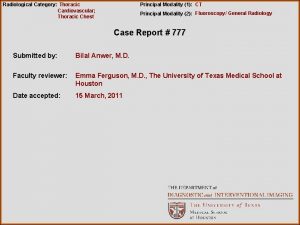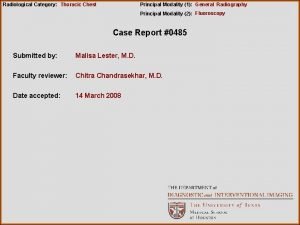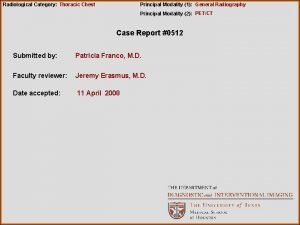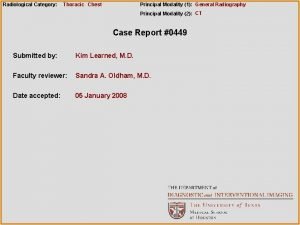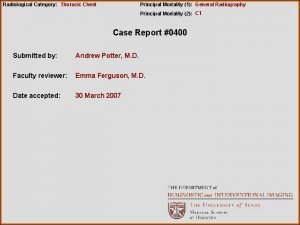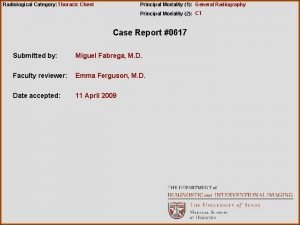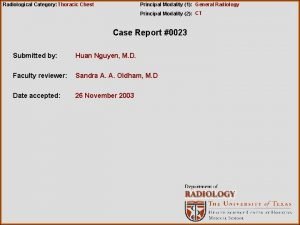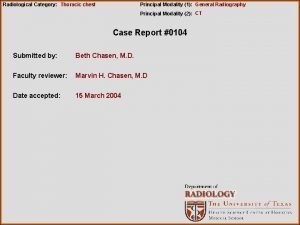Radiological Category Thoracic Chest Principal Modality 1 General









- Slides: 9

Radiological Category: Thoracic Chest Principal Modality (1): General Radiography Principal Modality (2): Portable Chest Radiograph Case Report #0622 Submitted by: Eduardo J. Gonzalez, M. D. Faculty reviewer: Emma Ferguson, M. D. Date accepted: 13 April 2009

Case History: 55 year old male status post surgery.

Radiological Presentations Post-operative Radiograph Pre-operative Radiograph

Test Your Diagnosis Which one of the following is your choice for the appropriate diagnosis? After your selection, go to next page. • Cardiac Herniation • Cardiac Volvulus • Normal Chest Film • Mislabeled Chest film

Findings and Differentials Findings: The normal left cardiac silhouette is absent and the cardiac mass projects from the right hilum to the lower right hemithorax. A helpful radiographic sign is a notch founded between the rounded heart border on the right of the great vessels. The rotated heart may also displace any chest tube or thoracostomy tube and rotation of any central venous catheter may be seen. Another helpful hint is to compare the heart silhouette with a nasogastric or feeding tube, as is our case with this patient. A "snow cone" configuration of the right cardiac border may be seen with impending or partial herniation through the pericardial defect. Differentials: • Cardiac Volvulus • Cardiac Herniation • Mislabeled Chest Film

Discussion Cardiac volvulus is rare and is most commonly seen as a complication of right intrapericardial pneumonectomy. It is seldom documented radiographically because of the acuteness and intensity of the signs and symptoms and the need for prompt surgical intervention. Chest radiographs are the most important confirmatory test when this condition is suspected. Cardiac volvulus into the right hemithorax in cases of right intrapericardial pneumonectomy was first reported in 1951. Herniation can occur regardless of the pericardial defect size due to the contractile force of the heart leading to protrusion through the surgical pericardial defect. This causes the heart to herniate through the pericardial defect into the right hemithorax. As the heart herniates into the right hemithorax, the SVC and the IVC fix the heart vertically and so the heart rotates around this vertical fixed axis in a counter-clockwise manner producing a folding effect on the right sided cardiac structures upon themselves with the apex of the LV pointing to the right costophrenic sulcus. This produces strangulation of the ventricles and obstruction of the RA and SVC.

Discussion Clinically, the patients exhibit symptoms of shock, cardiac failure and arrest, superior vena cava obstruction, or intense chest pain in the post-operative period. The differential includes herniation without volvulus of a portion of the heart, usually the atrial appendages through a congenital or other post-surgical pericardial defect. In this case, the position of the heart is normal, but the cardiac silhouette is atypical because the herniated appendage produces another mogul on the mediastinal surface. Another differential is that the radiograph is merely mislabeled as to the side. This can easily be investigated because, in this case, the pre-op chest radiograph showed the apex of the LV to be pointing towards the left hemidiaphragm and the stomach was in the LUQ in all radiographs prior to this intraoperative radiograph. The patient has situs solitus. On the intraoperative radiograph the nasogastric tube can be seen entering the stomach in the LUQ. So this was not a mislabeled radiograph. Removal of the remaining pericardium is regarded as the most effective surgical treatment although mortality is high, approaching 60%.

Diagnosis Cardiac Volvulus.

References 1. Brogdon B, Georgy B. An unusual twist. The British Journal of Radiology 1998; 71: 691 -692. 2. Castillo M, Oldham S. Cardiac Volvulus: Plain film recognition of an often fatal condition. AJR 1985; 145: 271 -272. 3. Brady M, Brogdon B. Cardiac Herniation and Volvulus: Radiographic Findings. Radiology 1986; 161: 657 -658.










